| Charleston
Gyre |

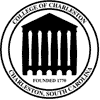 |
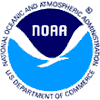 |
| Robin
Cheshire, Biological Science Technician for NOAA National Ocean
Service
The thing Robin
likes best about his job is being by the water. The only thing he doesn’t
really like is that the fieldwork sometimes keeps him away from his
family for long periods of time. When asked what kind of sea creature
he would like to be he said a seahorse. His reason was “they’re
cool”. |
Brian Degan, Fisheries Technician – NOAA Beaufort Lab
His father was a fisheries biologist but he said he thinks the main reason he became interested in fisheries and wildlife was because he grew up on a lake and spent a lot of time fishing. Originally he was interested in freshwater fisheries but working at CMAST turned his interest to marine science. Brian participates in a lot of field work, including the preparation for the cruises, the sorting and identifying of the samples and the data analysis. He said, “I never imagined that work could be like this, it’s so refreshing and Jon [Hare] is a great mentor and a great boss.” The only thing he could think of that’s remotely negative about his job is the governmental beaurocracy and office politics. When asked what
kind of sea creature he would be he really had to think about it. Finally
he decided on the blue fin tuna because of its “mystique”. |
Mike Green, Biological Science Technician – Fisheries, Beaufort lab. 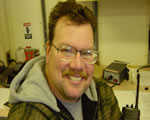 Mike
has 2 associates degrees. One is in science, the other in fisheries management.
Mike was brought up in the outdoors and has always enjoyed it. He decided
one day that he needed a career change from being a drummer in a band,
so he went back to school. While working on his science degree he enjoyed
the ichthyoplankton and zoology classes and decided to go on and get his
fisheries management degree as well. Mike
has 2 associates degrees. One is in science, the other in fisheries management.
Mike was brought up in the outdoors and has always enjoyed it. He decided
one day that he needed a career change from being a drummer in a band,
so he went back to school. While working on his science degree he enjoyed
the ichthyoplankton and zoology classes and decided to go on and get his
fisheries management degree as well.
While in school, Mike volunteered with numerous agencies. He worked for State Wildlife Management with endangered species, Camp Lejeune on a deer harvest project, Ft. Bragg and a turtle rescue project to name a few. When he graduated he sent out resumes and applications and was hired by NOAA’s National Marine Fisheries Service. He still loves it. His duties include supporting the principal investigators on cruises such as this one. This entails operating the MOCNESS, operating boats, repairing and maintaining equipment and compiling and analyzing data. He likes working with different equipment, likes the people he works with and enjoys seeing the final product when all the data has been analyzed and the results are published. Mike also sketches many of the fish species that he works with. There’s nothing he doesn’t like about his job but his advice would be to make sure you don’t get seasick, are able to live in small quarters, and are able to be away from friends and family for weeks at a time. Mike said he would
be a sunfish (mola mola) if he had a choice. He said they’re unique,
they range around the world, and no one could dislike the sunfish because
it’s so pretty. |
Jon Hare, Chief Scientist and Research Fisheries Biologist for NOAA Fisheries, Oceanography and Ecology Team, Beaufort, NC
His duties include supervising the Fisheries, Oceanography and Ecology Team at the Beaufort lab. The team of about 15 is made up federal and contract employees, students and post docs. He also leads research projects and spends a lot of time at the computer writing scientific papers and analyzing and compiling data. He feels that it’s very important that scientists have good communication skills. He really likes
the fact that his job combines research, writing and intellectual activities
as well as physical labor and field work. What he doesn’t like
is the bureaucracy. What kind of sea creature would he be? Jon says
he would be a lantern fish because it would be neat to experience an
environment that’s so different from the one we know. |
Frank Hernandez, Post-Doctorate Fisheries Biologist at the NOAA Beaufort Lab 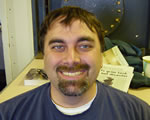 (A
Post-Doctorate position is a temporary position that someone takes after
they’ve received their Ph.D. in order to gain more experience and
knowledge in their field) (A
Post-Doctorate position is a temporary position that someone takes after
they’ve received their Ph.D. in order to gain more experience and
knowledge in their field)Frank received his bachelor’s degree in zoology from Louisiana State University. He went on to receive his master’s in marine biology from University of North Carolina Wilmington and his Ph.D. in oceanography and coastal sciences also from LSU. He has always been interested in nature, ecology and animals but he didn’t focus on the marine aspect of the environment until college. He took an ichthyology (the study of fish) class that he enjoyed very much and said the professor had a lot to do with that interest. He also had a 5-week marine science field course, during which he lived on the coast and got hooked on marine science. While working on his master’s degree, Frank spent some time at the NOAA Beaufort Lab working on a research project. He was using a computer model to describe the vertical distribution and behavior of larval fishes in the Gulf of Mexico. After he graduated he sent a resume to the Beaufort Lab and was offered the post-doc position in which he is currently employed. Some of Frank’s duties at the lab include overseeing the sorting of samples, working on numerous research projects, learning to create computer models from data, describing and predicting different variables regarding larval fishes and observing the characteristics of samples. Frank likes the people he works with and the working environment itself. He says everyone always pitches in to help each other. What he doesn’t like is that his position is temporary and he knows he’ll have to move on eventually. If he could be
any sea creature, Frank would be a red-lipped blenny. He says they have
personality and they look like they’re always doing something.
Also, they can hide in crevices, have cool teeth and live in nice warm
water. |
Marcy Hutchinson, Physiology and Ecology Technician 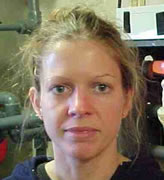 Marcy
actually works for a company called ORISE and is contracted by NOAA. She
got her Bachelor’s degree in biology with a concentration in marine
biology. She went on to get her Master’s degree, also in biology.
She said she had always been in interested in the ocean but chose her
career for the “fun factor”. Marcy
actually works for a company called ORISE and is contracted by NOAA. She
got her Bachelor’s degree in biology with a concentration in marine
biology. She went on to get her Master’s degree, also in biology.
She said she had always been in interested in the ocean but chose her
career for the “fun factor”.
Some of Marcy’s duties include sorting and identifying zooplankton, acquiring and analyzing chlorophyll samples and help write cruise reports. She’ll be working this summer in a marine protected area in the Dry Tortugas. The thing she likes
the most about her job is the field work and being outdoors. What she
doesn’t like is getting seasick! She decided that if she could
be any sea creature it would be a dolphin. Why? They’re fast,
graceful, intelligent and seem to have a lot of fun. |
Emma Jugovich, Research Technician for NOAA’s Beaufort Lab. 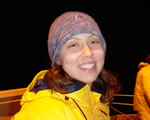 Emma
received her Bachelor’s degree in biology from Smith College. When
she was in high school she decided she wanted to be a “whale doctor”.
However, her college advisor was a marine scientist who specialized in
coral reefs so Emma ended up doing some work on coral reefs and then an
internship with the NOAA Beaufort Lab. That internship led to a full-time
position once she graduated. Emma
received her Bachelor’s degree in biology from Smith College. When
she was in high school she decided she wanted to be a “whale doctor”.
However, her college advisor was a marine scientist who specialized in
coral reefs so Emma ended up doing some work on coral reefs and then an
internship with the NOAA Beaufort Lab. That internship led to a full-time
position once she graduated.
Emma’s duties at the lab include a research project on fish energetics. What’s that? Well, they raise gray snapper and carefully monitor their food intake, their weight and length and their metabolic rates. They constantly vary the salinity and temperature of the water as well. The purpose of the study is to find the best salinity and temperature for optimum growth of this species. They hope this research will help them restore Florida Bay. She also participates in missions like the one we’re on now and helps sort various samples collected for research. Emma likes being
able to make a difference, as she’s always been concerned about
the environment. She doesn’t like the down time between experiments
or cruises because she likes to stay busy. When asked what kind of sea
creature she would be she quickly responded, “a cuttlefish.”
She thinks it’s really cool the way they communicate with each
other through color change and the movement of different body parts. |
| Rachel McEvers,
Program Manager for Project Oceanica
Rachel participates on research cruises throughout the southeast and helps create educational and outreach products from the science operations conducted on the cruises. She also helps instruct high school students on one-day research cruises and helps run the administrative aspect of Project Oceanica. The thing she likes best about her job is being outdoors and near the ocean. The thing she likes least is being cooped up in her office when she’s not outside! If she could be any sea creature she would be a gulper eel. Why? Because “they’re so strange looking and live in such an alien environment. They’re just bizarre.” |
Bill Smith, retired airline pilot for United Airlines 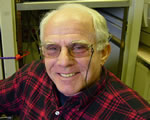 Bill
has a bachelor’s degree in marine biology from Gettysburg College
in Pennsylvania. During his junior year he took a two week course in which
he spent some time at the NOAA Beaufort Lab. (It wasn’t actually
a NOAA lab then because NOAA didn’t exist yet.) When he graduated
he was offered a position there and he worked in the lab for 3 years.
He had planned on going to North Carolina State for graduate school. However,
during his time at the lab he was a light plane pilot and was offered
a position as a pilot for a commercial airline. It was a tough decision
but he decided to leave the world of marine science to take the position.
Bill retired from the airlines five years ago. He kept in touch with people
from the lab over the years and has participated as a volunteer on the
last 6 cruises of this mission. He helps with all the science operations
and loves being out at sea. Bill is one of the nicest people you’ll
ever meet. Bill
has a bachelor’s degree in marine biology from Gettysburg College
in Pennsylvania. During his junior year he took a two week course in which
he spent some time at the NOAA Beaufort Lab. (It wasn’t actually
a NOAA lab then because NOAA didn’t exist yet.) When he graduated
he was offered a position there and he worked in the lab for 3 years.
He had planned on going to North Carolina State for graduate school. However,
during his time at the lab he was a light plane pilot and was offered
a position as a pilot for a commercial airline. It was a tough decision
but he decided to leave the world of marine science to take the position.
Bill retired from the airlines five years ago. He kept in touch with people
from the lab over the years and has participated as a volunteer on the
last 6 cruises of this mission. He helps with all the science operations
and loves being out at sea. Bill is one of the nicest people you’ll
ever meet. What
kind of sea creature would he be? He said he would be an Atlantic spotted
dolphin because they’re beautiful and they live out in the deep
sea all their lives. |
| Ph.
843-953-7263 |
Project
Oceanica Dept. of Geology & Environmental Geosciences College of Charleston Charleston, SC 29424 |
Fax
843-953-7850 |

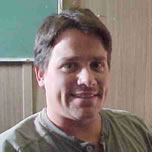 Robin
works in the Beaufort, NC NOAA lab. He has a Bachelor’s degree
in fisheries and wildlife science from North Carolina State University
and a Master’s degree in zoology also from NC State. Robin says
he decided to become a marine scientist when he moved to Wilmington,
NC and fell in love with the sea. Robin’s duties include fieldwork
in the Florida and Chesapeake Bays
monitoring fishes regarding sea grass habitats and marsh restoration.
In the lab he weighs, measures and records information about the fish
he has caught. He then analyzes and records his findings. He is very
interested in larval fish growth rates related to the warm water eddies
that spin off the Gulf Stream.
Robin
works in the Beaufort, NC NOAA lab. He has a Bachelor’s degree
in fisheries and wildlife science from North Carolina State University
and a Master’s degree in zoology also from NC State. Robin says
he decided to become a marine scientist when he moved to Wilmington,
NC and fell in love with the sea. Robin’s duties include fieldwork
in the Florida and Chesapeake Bays
monitoring fishes regarding sea grass habitats and marsh restoration.
In the lab he weighs, measures and records information about the fish
he has caught. He then analyzes and records his findings. He is very
interested in larval fish growth rates related to the warm water eddies
that spin off the Gulf Stream.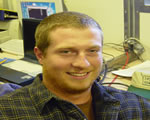 Brian
has a bachelor’s degree in fisheries and wildlife science from
North Carolina State. He worked for CMAST (Center for Marine Sciences
and Technology) at NC State after he graduated and when that ended he
was offered a temporary position at the Beaufort Lab. He had planned
on taking that position then going on to graduate school when it ended.
However, he was eventually offered a full-time position and decided
to take it.
Brian
has a bachelor’s degree in fisheries and wildlife science from
North Carolina State. He worked for CMAST (Center for Marine Sciences
and Technology) at NC State after he graduated and when that ended he
was offered a temporary position at the Beaufort Lab. He had planned
on taking that position then going on to graduate school when it ended.
However, he was eventually offered a full-time position and decided
to take it. 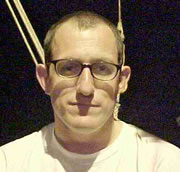 Jon
received his Bachelor’s degree in Biology from Wesleyan University
in Connecticut and his PH.D. in Oceanography at NY State University
at Stoneybrook. He had always been interested in the ocean and after
he got his B.S. he decided to volunteer at Woods Hole Oceanographic
Institute as a technician. This experience led him to pursue his Ph.D.
in Oceanography.
Jon
received his Bachelor’s degree in Biology from Wesleyan University
in Connecticut and his PH.D. in Oceanography at NY State University
at Stoneybrook. He had always been interested in the ocean and after
he got his B.S. he decided to volunteer at Woods Hole Oceanographic
Institute as a technician. This experience led him to pursue his Ph.D.
in Oceanography.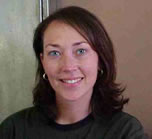 Rachel’s
organization, Project Oceanica is located on the campus of the College
of Charleston in Charleston, SC.
Oceanica is funded by NOAA’s National Ocean Service. She has a
Bachelor’s degree in both Public Relations and Marine Biology.
Rachel decided she wanted to be a marine scientist when she was very
young. She was always fascinated by TV shows and books that anything
to do with ocean creatures.
Rachel’s
organization, Project Oceanica is located on the campus of the College
of Charleston in Charleston, SC.
Oceanica is funded by NOAA’s National Ocean Service. She has a
Bachelor’s degree in both Public Relations and Marine Biology.
Rachel decided she wanted to be a marine scientist when she was very
young. She was always fascinated by TV shows and books that anything
to do with ocean creatures.